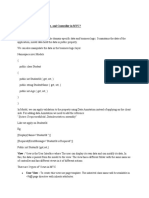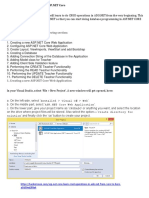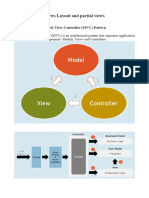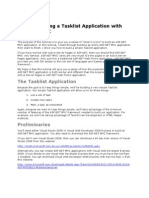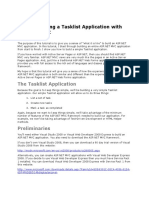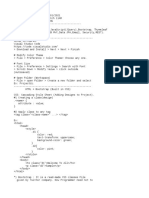Csharp 12
Csharp 12
Uploaded by
jhansi raniCopyright:
Available Formats
Csharp 12
Csharp 12
Uploaded by
jhansi raniOriginal Title
Copyright
Available Formats
Share this document
Did you find this document useful?
Is this content inappropriate?
Copyright:
Available Formats
Csharp 12
Csharp 12
Uploaded by
jhansi raniCopyright:
Available Formats
In this video we will discuss View Components in ASP.NET core with example.
View component example
In addition to page specific content, we want to display the following Employee
Head Count Summary on several pages in our application.
asp.net core view component example
Since, we want to display the Employee Head Count Summary on several pages, it
makes sense to create a reusable component.
What we do not want to do is include the code on each page. This approach
duplicates code.
We can't use a partial view either, because a partial view cannot have it's own
data access logic. It depends on the data passed from the parent view or razor
page. We do not want to include the code that retrieves data on each page. This is
again code duplication. We want something that can retrieve data independently and
render. View Component is a perfect choice for this.
View Components folder
Create View Components folder, in the root project directory. We will place all our
view components in this folder. Add a new class file with name -
HeadCountViewComponent.cs. Copy and paste the following code.
using Microsoft.AspNetCore.Mvc;
using RazorPagesTutorial.Services;
namespace RazorPagesTutorial.ViewComponents
{
public class HeadCountViewComponent : ViewComponent
{
private readonly IEmployeeRepository employeeRepository;
public HeadCountViewComponent(IEmployeeRepository employeeRepository)
{
this.employeeRepository = employeeRepository;
}
public IViewComponentResult Invoke()
{
var result = employeeRepository.EmployeeCountByDept();
return View(result);
}
}
}
View component class
View component class name ends with the suffix ViewComponent
It inherits from the ViewComponent base class
It supports dependency injection, just like a razor page or an MVC controller
A view component does not directly respond to an HTTP request. It is usually
invoked and consumed by a razor page, layout view or an MVC view.
When a view component is invoked, it calls the Invoke method.
Inovke() method returns IViewComponentResult.
Use InvokeAsync() method, if you want to call the View Component asynchronously.
View Component follows the MVC design pattern. It initialises a model and passes it
to a view by calling the View method.
Though it follows the MVC approach, it can be used both in an MVC project and a
razor pages project.
View Component view discovery
ASP.NET Core looks for the view in the following locations
Razor pages project
/Pages/Shared/Components/{View Component Name}/{View Name}
MVC project
/Views/{Controller Name}/Components/{View Component Name}/{View Name}
/Views/Shared/Components/{View Component Name}/{View Name}
Create view component view file
In the Shared folder, create Components folder.
In the Components folder, create a folder with the same name as the View Component.
Our view component name is HeadCountViewComponent. So create a folder with name
HeadCount. The suffix ViewComponent is not required.
In this folder create a file with name default.cshtml
At this point, the folder structure should look as shown below.
viewcomponent folder structure
Copy and paste the following code in default.cshtml
@model IEnumerable<DeptHeadCount>
<h3>Employee Head Count Summary</h3>
<table class="table table-bordered">
<thead class="thead-light">
<tr>
<th>Department</th>
<th>Head Count</th>
</tr>
</thead>
<tbody>
@foreach (var deptHeadCount in Model)
{
<tr>
<td>@deptHeadCount.Department</td>
<td>@deptHeadCount.Count</td>
</tr>
}
</tbody>
</table>
Rendering view component
Use Component.InvokeAsync to invoke the view component. We want to render it from
Details razor page. So include the following code on Details.cshtml page.
@await Component.InvokeAsync("HeadCount")
Supporting classes
DeptHeadCount.cs in Models project
namespace RazorPagesTutorial.Models
{
public class DeptHeadCount
{
public Dept Department { get; set; }
public int Count { get; set; }
}
}
IEmployeeRepository.cs in Models project
namespace RazorPagesTutorial.Services
{
public interface IEmployeeRepository
{
// Other methods
IEnumerable<DeptHeadCount> EmployeeCountByDept();
}
}
MockEmployeeRepository.cs in Models project
namespace RazorPagesTutorial.Services
{
public class MockEmployeeRepository : IEmployeeRepository
{
private List<Employee> _employeeList;
public MockEmployeeRepository()
{
_employeeList = new List<Employee>()
{
new Employee() { Id = 1, Name = "Mary", Department = Dept.HR,
Email = "mary@pragimtech.com", PhotoPath="mary.png" },
new Employee() { Id = 2, Name = "John", Department = Dept.IT,
Email = "john@pragimtech.com", PhotoPath="john.png" },
new Employee() { Id = 3, Name = "Sara", Department = Dept.IT,
Email = "sara@pragimtech.com", PhotoPath="sara.png" },
new Employee() { Id = 4, Name = "David", Department = Dept.Payroll,
Email = "david@pragimtech.com" },
};
}
public IEnumerable<DeptHeadCount> EmployeeCountByDept()
{
return _employeeList.GroupBy(e => e.Department)
.Select(g => new DeptHeadCount()
{
Department = g.Key.Value,
Count = g.Count()
}).ToList();
}
}
}
You might also like
- Understanding Form Validation Validation Using Dataannotations in Mvc5 Custom Validations Using Data Annotation Fetching Data From DatabaseNo ratings yetUnderstanding Form Validation Validation Using Dataannotations in Mvc5 Custom Validations Using Data Annotation Fetching Data From Database19 pages
- It Is Intimated That Following Lectures Will Not Be Repeated and Would Be Part of Mid-Term& Final Exam As WellNo ratings yetIt Is Intimated That Following Lectures Will Not Be Repeated and Would Be Part of Mid-Term& Final Exam As Well19 pages
- CRUD (Create, Read, Update, Delete) Application Using Fire Store (Firebase)No ratings yetCRUD (Create, Read, Update, Delete) Application Using Fire Store (Firebase)8 pages
- 016 - Implementing Basic CRUD Functionality With The Entity Framework in ASP PDFNo ratings yet016 - Implementing Basic CRUD Functionality With The Entity Framework in ASP PDF20 pages
- Can You Explain Model, View, and Controller in MVC?No ratings yetCan You Explain Model, View, and Controller in MVC?39 pages
- Asp .Net MVC Validation Process Using Data AnnotationNo ratings yetAsp .Net MVC Validation Process Using Data Annotation9 pages
- Consume Web API in ASP - Net MVC With Crud ActionsNo ratings yetConsume Web API in ASP - Net MVC With Crud Actions19 pages
- This Tutorial Is Divided Into Following Section:: A0109ed2f8a4No ratings yetThis Tutorial Is Divided Into Following Section:: A0109ed2f8a420 pages
- Populate Data From Database Into JTable in Netbeans100% (1)Populate Data From Database Into JTable in Netbeans13 pages
- Django CRUD (Create, Retrieve, Update, Delete) Function Based ViewsNo ratings yetDjango CRUD (Create, Retrieve, Update, Delete) Function Based Views8 pages
- Building Host Environment To Start The Application (Core 1.0)No ratings yetBuilding Host Environment To Start The Application (Core 1.0)5 pages
- Work With Partial View in MVC FrameworkNo ratings yetWork With Partial View in MVC Framework12 pages
- Java Spring Boot Microservices Example - Step by Step Guide - GeNo ratings yetJava Spring Boot Microservices Example - Step by Step Guide - Ge13 pages
- Tweet This: Download The Full Source Code of This Application From GithubNo ratings yetTweet This: Download The Full Source Code of This Application From Github31 pages
- Unit-4 Creating ASPdotnet Core MVC Application2No ratings yetUnit-4 Creating ASPdotnet Core MVC Application227 pages
- Crud Operations in ASP Net MVC 5 Using Ado PDF100% (1)Crud Operations in ASP Net MVC 5 Using Ado PDF11 pages
- Validating With Sharp Architecture and MVC 2: D M V M VNo ratings yetValidating With Sharp Architecture and MVC 2: D M V M V4 pages
- MVC:: Creating A Tasklist Application WithNo ratings yetMVC:: Creating A Tasklist Application With16 pages
- MCTS 70-515 Exam: Web Applications Development with Microsoft .NET Framework 4 (Exam Prep)From EverandMCTS 70-515 Exam: Web Applications Development with Microsoft .NET Framework 4 (Exam Prep)4/5 (1)
- Programming Languages For Use in Safety-Related ApplicationsNo ratings yetProgramming Languages For Use in Safety-Related Applications7 pages
- Sistemas Operativos: Sistema de ArchivosNo ratings yetSistemas Operativos: Sistema de Archivos58 pages
- v2 GTM Data Layer Cheat Sheet Analytics ManiaNo ratings yetv2 GTM Data Layer Cheat Sheet Analytics Mania20 pages
- Lab 6.2.9 Firmware Upgrade of A Catalyst 2900 Series Switch: ObjectiveNo ratings yetLab 6.2.9 Firmware Upgrade of A Catalyst 2900 Series Switch: Objective5 pages
- 9 OIW-HBO-0004-EX-002 - Remote Access HandbookNo ratings yet9 OIW-HBO-0004-EX-002 - Remote Access Handbook14 pages
- Programming Fundamentals: Dr. Sheikh Faisal Rashid Department of Computer Science and Engineering UET LahoreNo ratings yetProgramming Fundamentals: Dr. Sheikh Faisal Rashid Department of Computer Science and Engineering UET Lahore12 pages
- Immediate download The Definitive Guide to the ARM Cortex M3 Second Edition Joseph Yiu ebooks 2024No ratings yetImmediate download The Definitive Guide to the ARM Cortex M3 Second Edition Joseph Yiu ebooks 202477 pages
- Ucadefaultobjects - CFG Configuration File and For The "Iec 61850" Setting The Iec61850Defaultobjects - CFG FileNo ratings yetUcadefaultobjects - CFG Configuration File and For The "Iec 61850" Setting The Iec61850Defaultobjects - CFG File5 pages
- Google's Android: Study Report With Other Mobile Operating SystemNo ratings yetGoogle's Android: Study Report With Other Mobile Operating System19 pages
- File Information For FFF Mesh Information For FFF Domain Physics For FFF Boundary Physics For FFFNo ratings yetFile Information For FFF Mesh Information For FFF Domain Physics For FFF Boundary Physics For FFF6 pages
- Features: Fire Alarm Network Annunciators Truesite Workstations Version 6.01No ratings yetFeatures: Fire Alarm Network Annunciators Truesite Workstations Version 6.0118 pages
- Quick Start Guide Vodafone Mobile Broadband USB StickNo ratings yetQuick Start Guide Vodafone Mobile Broadband USB Stick16 pages
- Java Programming: H.K.Vedamurthy Asst ProfessorNo ratings yetJava Programming: H.K.Vedamurthy Asst Professor43 pages
- Programming 2: Object-Oriented Programming With JavaNo ratings yetProgramming 2: Object-Oriented Programming With Java50 pages













